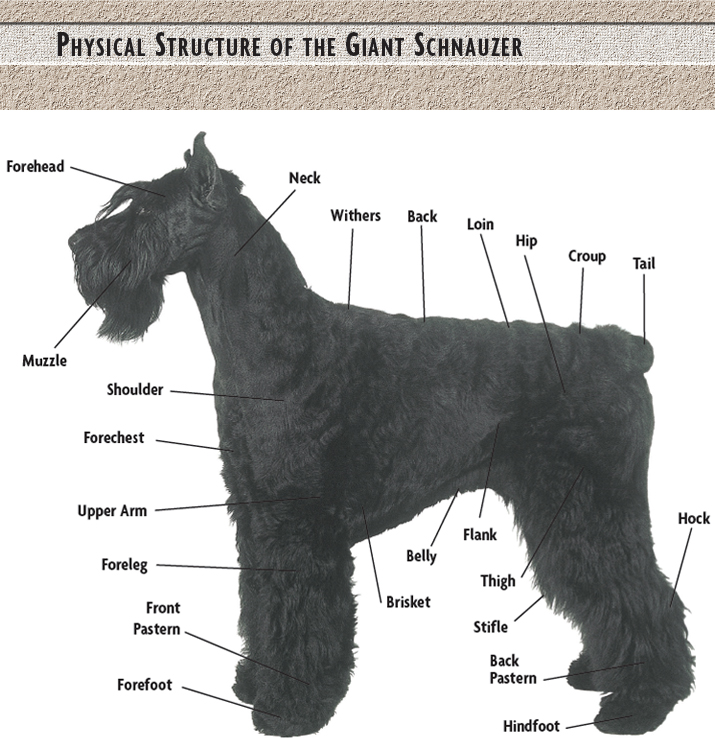

BASIC TRAINING PRINCIPLES: PUPPY VS. ADULT
There’s a big difference between training an adult dog and training a young puppy. With a young puppy, everything is new. At eight to ten weeks of age, he will be experiencing many things, and he has nothing with which to compare these experiences. Up to this point, he has been with his dam and littermates, not one-on-one with people except in his interactions with his breeder and visitors to the litter.
When you first bring the puppy home, he is eager to please you. This means that he accepts doing things your way. During the next couple of months, he will absorb the basis of everything he needs to know for the rest of his life. This early age is even referred to as the “sponge” stage. After that, for the next 18 months, it’s up to you to reinforce good manners by building on the foundation that you’ve established. Once your puppy is reliable in basic commands and behavior and has reached the appropriate age, you may gradually introduce him to some of the interesting sports, games and activities available to pet owners and their dogs.
CREATURES OF HABIT
Canine behaviorists and trainers aptly describe dogs as “creatures of habit,” meaning that dogs respond to structure in their daily lives and welcome a routine. Do not interpret this to mean that dogs enjoy endless repetition in their training sessions. Dogs get bored just as humans do. Keep training sessions interesting and exciting. Vary the commands and the locations in which you practice. Give short breaks for play in between lessons. A bored student will never be the best performer in the class.
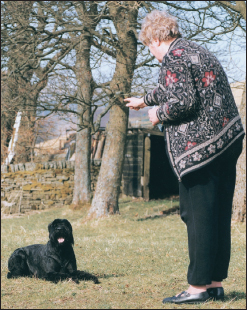
Training a dog of any breed presents both challenges and rewards to owners.
Raising your puppy is a family affair. Each member of the family must know what rules to set forth for the puppy and how to use the same one-word commands to mean exactly the same thing every time. Even if yours is a large family, one person will soon be considered by the pup to be the leader, the Alpha person in his pack, the “boss” who must be obeyed. Often that highly regarded person turns out to be the one who feeds the puppy. Food ranks very high on the puppy’s list of important things! That’s why your puppy is rewarded with small treats along with verbal praise when he responds to you correctly. As the puppy learns to do what you want him to do, the food rewards are gradually eliminated and only the praise remains. If you were to keep up with the food treats, you could have two problems on your hands—an obese dog and a beggar.
Training begins the minute your Giant Schnauzer puppy steps through the doorway of your home, so don’t make the mistake of putting the puppy on the floor and telling him by your actions to “Go for it! Run wild!” Even if this is your first puppy, you must act as if you know what you’re doing: be the boss. An uncertain pup may be terrified to move, while a bold one will be ready to take you at your word and start plotting to destroy the house! Before you collected your puppy, you decided where his own special place would be, and that’s where to put him when you first arrive home. Give him a house tour after he has investigated his area and had a nap and a bathroom “pit stop.”
OUR CANINE KIDS
“Everything I learned about parenting, I learned from my dog.” How often adults recognize that their parenting skills are mere extensions of the education they acquired while caring for their dogs. Many owners refer to their dogs as their “kids” and treat their canine companions like real members of the family. Surveys indicate that a majority of dog owners talk to their dogs regularly, celebrate their dogs’ birthdays and purchase Christmas gifts for their dogs. Another survey shows that dog owners take their dogs to the veterinarian more frequently than they visit their own physicians.
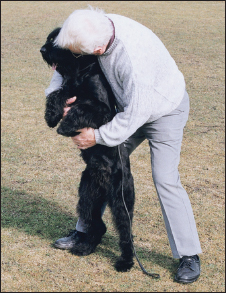
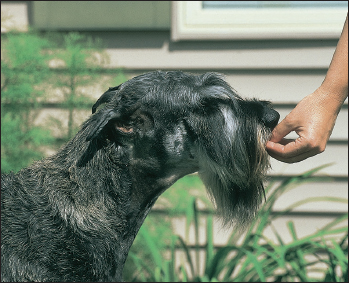
Treats are always welcomed by a Giant as as reward for a job well done.
It’s worth mentioning here that, if you’ve adopted an adult dog that is completely trained to your liking, lucky you! You’re off the hook! However, if that dog spent his life up to this point in a kennel, or even in a good home but without any real training, be prepared to tackle the job ahead. A dog three years of age or older with no previous training cannot be blamed for not knowing what he was never taught. While the dog is trying to understand and learn your rules, at the same time he has to unlearn many of his previously self-taught habits and general view of the world.
Working with a professional trainer will speed up your progress with an adopted adult dog. You’ll need patience, too. Some new rules may be close to impossible for the dog to accept. After all, he’s been successful so far by doing everything his way! (Patience again.) He may agree with your instruction for a few days and then slip back into his old ways, so you must be just as consistent and understanding in your teaching as you would be with a puppy. Your dog has to learn to pay attention to your voice, your family, the daily routine, new smells, new sounds and even, in some cases, a new climate.
WHO’S TRAINING WHOM?
Dog training is a black-and-white exercise. The correct response to a command must be absolute, and the trainer must insist on completely accurate responses from the dog. A trainer cannot command his dog to sit and then settle for the dog’s melting into the down position. Often owners are so pleased that their dogs “did something” in response to a command that they just shrug and say, “OK, Down” even though they wanted the dog to sit. You want your dog to respond to the command without hesitation: he must respond at that moment and correctly every time.
One of the most important things to find out about a newly adopted adult dog is his reaction to children (yours and others), strangers and your friends, and how he acts upon meeting other dogs. If he was not socialized with dogs as a puppy, this could be a major problem. This does not mean that he’s a “bad” dog, a vicious dog or an aggressive dog; rather, it means that he has no idea how to read another dog’s body language. There’s no way for him to tell whether the other dog is a friend or foe. Survival instinct takes over, telling him to attack first and ask questions later. This definitely calls for professional help and, even then, may not be a behavior that can be corrected 100% reliably (or even at all). If you have a puppy, this is why it is so very important to introduce your young puppy properly to other puppies and “dog-friendly” adult dogs.
HOUSE-TRAINING YOUR GIANT SCHNAUZER
Dogs are tactility-oriented when it comes to house-training. In other words, they respond to the surface on which they are given approval to eliminate. The choice is yours (the dog’s version is in parentheses): The lawn (including the neighbors’ lawns)? A bare patch of earth under a tree (where people like to sit and relax in the summertime)? Concrete steps or patio (all sidewalks, garages and basement floors)? The curbside (watch out for cars)? A small area of crushed stone in a corner of the yard (mine!)? The latter is the best choice if you can manage it, because it will remain strictly for the dog’s use and is easy to keep clean.
BE UPSTANDING!
You are the dog’s leader. During training, stand up straight so your dog looks up at you and therefore up to you. Say the command words distinctly, in a clear, declarative tone of voice. (No barking!) Give rewards only as the correct response takes place (remember your timing!). Praise, smiles and treats are “rewards” used to positively reinforce correct responses. Don’t repeat a mistake. Just change to another exercise—you will soon find success!
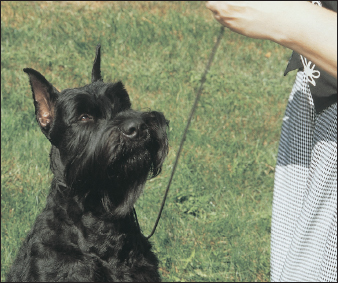
You can start out with paper-training indoors and switch over to an outdoor surface as the puppy matures and gains control over his need to eliminate. For the nay-sayers, don’t worry—this won’t mean that the dog will soil on every piece of newspaper lying around the house. You are training him to go outside, remember? Starting out by paper-training often is the only choice for a city dog.
WHEN YOUR PUPPY’S “GOT TO GO”
Your puppy’s need to relieve himself is seemingly non-stop, but signs of improvement will be seen each week. From 8 to 10 weeks old, the puppy will have to be taken outside every time he wakes up, about 10-15 minutes after every meal and after every period of play—all day long, from first thing in the morning until his bedtime! That’s a total of ten or more trips per day to teach the puppy where it’s okay to relieve himself. With that schedule in mind, you can see that house-training a young puppy is not a part-time job. It requires someone to be home all day.
If that seems overwhelming or impossible, do a little planning. For example, plan to pick up your puppy at the start of a vacation period. If you can’t get home in the middle of the day, plan to hire a dog-sitter or ask a neighbor to come over to take the pup outside, feed him his lunch and then take him out again about ten or so minutes after he’s eaten. Also make arrangements with that or another person to be your “emergency” contact if you have to stay late on the job. Remind yourself—repeatedly—that this hectic schedule improves as the puppy gets older.
LEASH TRAINING
House-training and leash training go hand in hand, literally. When taking your puppy outside to do his business, lead him there on his leash. Unless an emergency potty run is called for, do not whisk the puppy up into your arms and take him outside. If you have a fenced yard, you have the advantage of letting the puppy loose to go out, but it’s better to put the dog on the leash and take him to his designated place in the yard until he is reliably housetrained. Taking the puppy for a walk is the best way to house-train a dog. The dog will associate the walk with his time to relieve himself, and the exercise of walking stimulates the dog’s bowels and bladder. Dogs that are not trained to relieve themselves on a walk may hold it until they get back home, which of course defeats half the purpose of the walk.

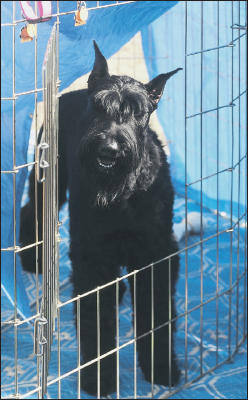
A wire pen is helpful for confining your Giant when you travel and want to give him a safe place of his own. Be sure to get a pen that is tall enough and roomy enough for a large dog.
HOME WITHIN A HOME
Your Giant Schnauzer puppy needs to be confined to one secure, puppy-proof area when no one is able to watch his every move. Generally the kitchen is the place of choice because the floor is washable. Likewise, it’s a busy family area that will accustom the pup to a variety of noises, everything from pots and pans to the telephone, blender and dishwasher. He will also be enchanted by the smell of your cooking (and will never be critical when you burn something). An exercise pen (also called an “ex-pen,” a puppy version of a playpen) within the room of choice is an excellent means of confinement for a young pup. He can see out and has a certain amount of space in which to run about, but he is safe from dangerous things like electrical cords, heating units, trash baskets or open kitchen-supply cabinets. Place the pen where the puppy will not get a blast of heat or air conditioning.
In the pen, you can put a few toys, his bed (which can be his crate if the dimensions of pen and crate are compatible) and a few layers of newspaper in one small corner, just in case. A water bowl can be hung at a convenient height on the side of the ex-pen so it won’t become a splashing pool for an innovative puppy. His food dish can go on the floor.
EXTRA! EXTRA!
The headlines read: “Puppy Piddles Here!” Breeders commonly use newspapers to line their whelping pens, so puppies learn to associate newspapers with relieving themselves. Do not use newspapers to line your pup’s crate, as this will signal to your puppy that it is OK to urinate in his crate. If you are starting out by paper-training your puppy, you will layer newspapers on a section of the floor near the door he uses to go outside. You should encourage the puppy to use the papers to relieve himself, and bring him there whenever you see him getting ready to go. Little by little, you will reduce the size of the newspaper-covered area so that the puppy will learn to relieve himself “on the other side of the door.”
Crates are something that pet owners are at last getting used to for their dogs. Wild or domestic canines have always preferred to sleep in den-like safe spots, and that is exactly what the crate provides. How often have you seen adult dogs that choose to sleep under a table or chair even though they have full run of the house? It’s the den connection.
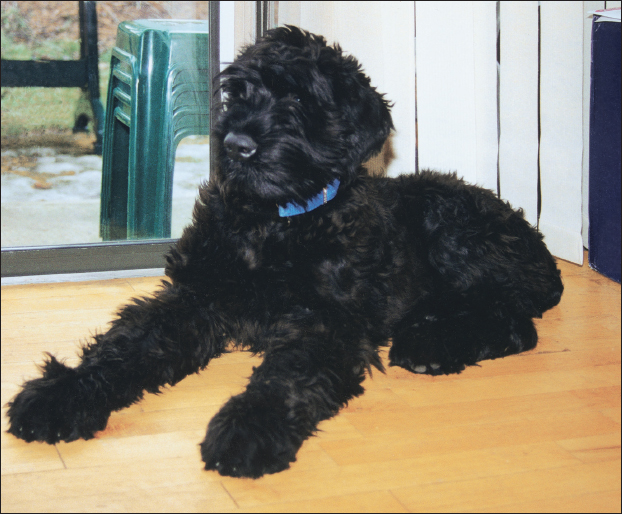
Puppies have their way of signaling their need to go outside. Some will wait by the door, hoping that you’ll get the hint.
In your “happy” voice, use the word “Crate” every time you put the pup into his den. If he’s new to a crate, toss in a small biscuit for him to chase the first few times. At night, after he’s been outside, he should sleep in his crate. The crate may be kept in his designated area at night or, if you want to be sure to hear those wake-up yips in the morning, put the crate in a corner of your bedroom. However, don’t make any response whatsoever to whining or crying. If he’s completely ignored, he’ll settle down and get to sleep.
Good bedding for a young puppy is an old folded bath towel or an old blanket, something that is easily washable and disposable if necessary (“accidents” will happen!). Never put newspaper in the puppy’s crate. Also, those old ideas about adding a clock to replace his mother’s heartbeat, or a hot-water bottle to replace her warmth, are just that—old ideas. The clock could drive the puppy nuts, and the hot-water bottle could end up as a very soggy waterbed! An extremely good breeder would have introduced your puppy to the crate by letting two pups sleep together for a couple of nights, followed by several nights alone. How thankful you will be if you found that breeder!
Safe toys in the pup’s crate or area will keep him occupied, but monitor their condition closely. Discard any toys that show signs of being chewed to bits. Squeaky parts, bits of stuffing or plastic or any other small pieces can cause intestinal blockage or possibly choking if swallowed.
POTTY COMMAND
Most dogs love to please their masters; there are no bounds to what dogs will do to make their owners happy. The potty command is a good example of this theory. If toileting on command makes the master happy, then more power to him. Puppies will obligingly piddle if it really makes their keepers smile. Some owners can be creative about which word they will use to command their dogs to relieve themselves. Some popular choices are “Potty,” “Tinkle,” “Piddle,” “Let’s go,” “Hurry up” and “Toilet.” Give the command every time your puppy goes into position and the puppy will begin to associate his business with the command.
PROGRESSING WITH POTTY-TRAINING
After you’ve taken your puppy out and he has relieved himself in the area you’ve selected, he can have some free time with the family as long as there is someone responsible for watching him. That doesn’t mean just someone in the same room who is watching TV or busy on the computer, but one person who is doing nothing other than keeping an eye on the pup, playing with him on the floor and helping him understand his position in the pack.
This first taste of freedom will let you begin to set the house rules. If you don’t want the dog on the furniture, now is the time to prevent his first attempts to jump up onto the couch. The word to use in this case is “Off,” not “Down.” “Down” is the word you will use to teach the down position, which is something entirely different.
SOMEBODY TO BLAME
House-training a puppy can be frustrating for the puppy and the owner alike. The puppy does not instinctively understand the difference between defecating on the pavement outside and on the ceramic tile in the kitchen. He is confused and frightened by his human’s exuberant reactions to his natural urges. The owner, arguably the more intelligent of the duo, is also frustrated that he cannot convince his puppy to obey his commands and instructions.
In frustration, the owner may struggle with the temptation to discipline the puppy, scold him or even strike him on the rear end. Not only are harsh corrections unnecessary and inappropriate but they also will defeat your purpose in gaining your puppy’s trust and respect. Don’t blame your nine-week-old puppy. Blame yourself for not being 100% consistent in the puppy’s lessons and routine. The lesson here is simple: try harder and your puppy will succeed.
Most corrections at this stage come in the form of simply distracting the puppy. Instead of telling him “No” for “Don’t chew the carpet,” distract the chomping puppy with a toy and he’ll forget about the carpet.
As you are playing with the pup, do not forget to watch him closely and pay attention to his body language. Whenever you see him begin to circle or sniff, take the puppy outside to relieve himself. If you are paper-training, put him back into his confined area on the newspapers. In either case, praise him as he eliminates while he actually is in the act of relieving himself. Three seconds after he has finished is too late! You’ll be praising him for running toward you, or picking up a toy or whatever he may be doing at that moment, and that’s not what you want to be praising him for. Timing is a vital tool in all dog training. Use it.

His business outside is done, so this young Giant is letting his owners know that it’s time to come back in!
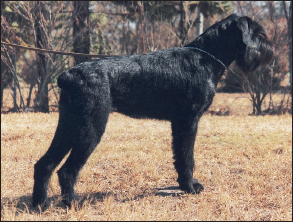
DAILY SCHEDULE
How many relief trips does your Giant need per day? A puppy up to the age of 14 weeks will need to go outside about 8 to 12 times per day! You will have to take the pup out any time he starts sniffing around the floor or turning in small circles, as well as after naps, meals, games and lessons or whenever he’s released from his crate. Once the puppy is 14 to 22 weeks of age, he will require only 6 to 8 relief trips. At the ages of 22 to 32 weeks, the puppy will require about 5 to 7 trips. Adult dogs typically require 4 relief trips per day: in the morning, afternoon, evening and late at night.
Remove soiled newspapers immediately and replace them with clean ones. You may want to take a small piece of soiled paper and place it in the middle of the new clean papers, as the scent will attract him to that spot when it’s time to go again. That scent attraction is why it’s so important to clean up any messes made in the house by using a product specially made to eliminate the odor of dog urine and droppings. Regular household cleansers won’t do the trick. Pet shops sell the best pet deodorizers. Invest in the largest container you can find.
Scent attraction eventually will lead your pup to his chosen spot outdoors; this is the basis of outdoor training. When you take your puppy outside to relieve himself, use a one-word command such as “Outside” or “Go-potty” (that’s one word to the puppy!) as you pick him up and attach his leash. Then put him down in his area. If he is too big for you to carry, snap the leash on quickly and lead him to his spot. Now comes the hard part—hard for you, that is. Just stand there until he urinates and defecates. Move him a few feet in one direction or another if he’s just sitting there looking at you, but remember that this is neither playtime nor time for a walk. This is strictly a business trip! Then, as he circles and squats (remember your timing!), give him a quiet “Good dog” as praise. If you start to jump for joy, ecstatic over his performance, he’ll do one of two things: either he will stop midstream, as it were, or he’ll do it again for you—in the house—and expect you to be just as delighted!
Give him five minutes or so and, if he doesn’t go in that time, take him back indoors to his confined area and try again in another ten minutes, or immediately if you see him sniffing and circling. By careful observation, you’ll soon work out a successful schedule.
Accidents, by the way, are just that—accidents. Clean them up quickly and thoroughly, without comment, after the puppy has been taken outside to finish his business and then put back into his area or crate. If you witness an accident in progress, say “No!” in a stern voice and get the pup outdoors immediately. No punishment is needed. You and your puppy are just learning each other’s language, and sometimes it’s easy to miss a puppy’s message. Chalk it up to experience and watch more closely from now on.
BASIC PRINCIPLES OF DOG TRAINING
1. Start training early. A young puppy is ready, willing and able.
2. Timing is your all-important tool. Praise at the exact time that the dog responds correctly. Pay close attention.
3. Patience is almost as important as timing!
4. Repeat! The same word has to mean the same thing every time.
5. In the beginning, praise all correct behavior verbally, along with treats and petting.
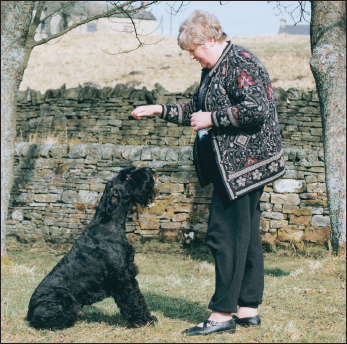
A treat in hand is sure to keep your Giant focused on the lesson.
KEEPING THE PACK ORDERLY
Discipline is a form of training that brings order to life. For example, military discipline is what allows the soldiers in an army to work as one. Discipline is a form of teaching and, in dogs, is the basis of how the successful pack operates. Each member knows his place in the pack and all respect the leader, or Alpha dog. It is essential for your puppy that you establish this type of relationship, with you as the Alpha, or leader. It is a form of social coexistence that all canines recognize and accept. Discipline, therefore, is never to be confused with punishment. When you teach your puppy how you want him to behave, and he behaves properly and you praise him for it, you are disciplining him with a form of positive reinforcement.
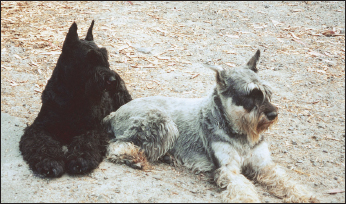
TEACHER’S PET
Dogs are individuals, not robots, with many traits basic to their breed. Some, bred to work alone, are independent thinkers; others rely on you to call the shots. If you have enrolled in a training class, your instructor can offer alternative methods of training based on your individual dog’s instincts and personality. You may benefit from using a different type of collar or switching to a class with different kinds of dogs.
For a dog, rewards come in the form of praise, a smile, a cheerful tone of voice, a few friendly pats or a rub of the ears. Rewards are also small food treats. Obviously, that does not mean bits of regular dog food. Instead, treats are very small bits of special things like cheese or pieces of soft dog treats. The idea is to reward the dog with something very small that he can taste and swallow, providing instant positive reinforcement. If he has to take time to chew the treat, he will have forgotten what he did to earn it by the time he is finished!
Your puppy should never be physically punished. The displeasure shown on your face and in your voice is sufficient to signal to the pup that he has done something wrong. He wants to please everyone higher up on the social ladder, especially his leader, so a scowl and harsh voice will take care of the error. Growling out the word “Shame!” when the pup is caught in the act of doing something wrong is better than the repetitive “No.” Some dogs hear “No” so often that they begin to think it’s their name! By the way, do not use the dog’s name when you’re correcting him. His name is reserved to get his attention for something pleasant about to take place.
There are punishments that have nothing to do with you. For example, your dog may think that chasing cats is one reason for his existence. You can try to stop it as much as you like but without success, because it’s such fun for the dog. But one good hissing, spitting, swipe of a cat’s claws across the dog’s nose will put an end to the game forever. Intervene only when your dog’s eyeball is seriously at risk. Cat scratches can cause permanent damage to an innocent but annoying puppy.
TIPS FOR TRAINING AND SAFETY
1. Whether on- or off-leash, practice only in a fenced area.
2. Remove the training collar when the training session is over.
3. Don’t try to break up a dog fight.
4. “Come,” “Leave it” and “Wait” are safety commands.
5. The dog belongs in a crate or behind a barrier when riding in the car.
6. Don’t ignore the dog’s first sign of aggression. Aggression only gets worse, so take it seriously.
7. Keep the faces of children and dogs separated.
8. Pay attention to what the dog is chewing.
9. Keep the vet’s number near your phone.
10. “Okay” is a useful release command.
PUPPY KINDERGARTEN
COLLAR AND LEASH
Before you begin your Giant Schnauzer puppy’s education, he must be used to his collar and leash. Choose a collar for your puppy that is secure, but not heavy or bulky. He won’t enjoy training if he’s uncomfortable. A flat buckle collar is fine for everyday wear and for initial puppy training. For older dogs, there are several types of training collars such as the martingale, which is a double loop that tightens slightly around the neck, or the head collar, which is similar to a horse’s halter. Do not use a chain choke collar with a puppy and, with the adult, do not use the choke unless you have been specifically shown how to put it on and how to use it. You may not be disposed to use a chain choke collar even if your breeder has told you that it’s suitable for your Giant Schnauzer.
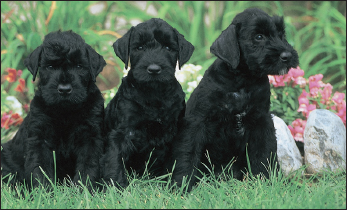
Through care and training, you facilitate your Giant pup’s transition from his canine pack to his place in your family pack.
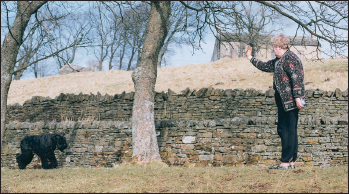
You must be able to get your Giant’s attention no matter how far from you he is.
A lightweight 6-foot woven cotton or nylon training leash is preferred by most trainers because it is easy to fold up in your hand and comfortable to hold because there is a certain amount of give to it. There are lessons where the dog will start off 6 feet away from you at the end of the leash. The leash used to take the puppy outside to relieve himself is shorter because you don’t want him to roam away from his area. The shorter leash will also be the one to use when you walk the puppy.
If you’ve been wise enough to enroll in a Puppy Kindergarten training class, suggestions will be made as to the best collar and leash for your young puppy. I say “wise” because your puppy will be in a class with puppies in his age range (up to five months old) of all breeds and sizes. It’s the perfect way for him to learn the right way (and the wrong way) to interact with other dogs as well as their people. You cannot teach your puppy how to interpret another dog’s sign language. For a first-time puppy owner, these socialization classes are invaluable. For experienced dog owners, they are a real boon to further training.
ATTENTION
You’ve been using the dog’s name since the minute you collected him from the breeder, so you should be able to get his attention by saying his name—with a big smile and in an excited tone of voice. His response will be the puppy equivalent of “Here I am! What are we going to do?” Your immediate response (if you haven’t guessed by now) is “Good dog.” Rewarding him at the moment he pays attention to you teaches him the proper way to respond when he hears his name.
EXERCISES FOR A BASIC CANINE EDUCATION
THE SIT EXERCISE
There are several ways to teach the puppy to sit. The first one is to catch him whenever he is about to sit and, as his backside nears the floor, say “Sit, good dog!” That’s positive reinforcement and, if your timing is sharp, he will learn that what he’s doing at that second is connected to your saying “Sit” and that you think he’s clever for doing it!
READY, SIT, GO!
On your marks, get set: train! Most professional trainers agree that the sit command is the place to start your dog’s formal education. Sitting is a natural posture for most dogs, and they respond to the sit exercise willingly and readily. For every lesson, begin with the sit command so that you start out on a successful note; likewise, you should practice the sit command at the end of every lesson as well, because you always want to end on a high note.
Another method is to start with the puppy on his leash in front of you. Show him a treat in the palm of your right hand. Bring your hand up under his nose and, almost in slow motion, move your hand up and back so his nose goes up in the air and his head tilts back as he follows the treat in your hand. At that point, he will have to either sit or fall over, so as his back legs buckle under, say “Sit, good dog,” and then give him the treat and lots of praise. You may have to begin with your hand lightly running up his chest, actually lifting his chin up until he sits. Some (usually older) dogs require gentle pressure on their hindquarters with the left hand, in which case the dog should be on your left side. Puppies generally do not appreciate this physical dominance.
After a few times, you should be able to show the dog a treat in the open palm of your hand, raise your hand waist-high as you say “Sit” and have him sit. You will thereby have taught him two things at the same time. Both the verbal command and the motion of the hand are signals for the sit. Your puppy is watching you almost more than he is listening to you, so what you do is just as important as what you say.
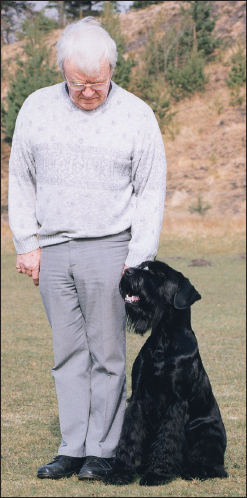
Teaching a dog to sit is a simple lesson, which is why it is usually the first command taught.
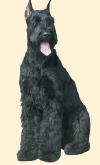
A SIMPLE “SIT”
When you command your dog to sit, use the word “Sit.” Do not say “Sit down,” as your dog will not know whether you mean “Sit” or “Down,” or maybe you mean both. Be clear in your instructions to your dog; use one-word commands and always be consistent.
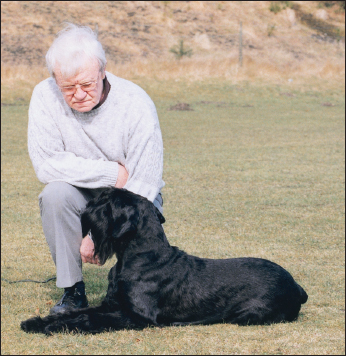
Your Giant may need a bit of coaxing to assume the down position on command.
Don’t save any of these drills only for training sessions. Use them as much as possible at odd times during a normal day. The dog should always sit before being given his food dish. He should sit to let you go through a doorway first, when the doorbell rings or when you stop to speak to someone on the street.
THE DOWN EXERCISE
Before beginning to teach the down command, you must consider how the dog feels about this exercise. To him, “Down” is a submissive position. Being flat on the floor with you standing over him is not his idea of fun. It’s up to you to let him know that, while it may not be fun, the reward of your approval is worth his effort.
Start with the puppy on your left side in a sit position. Hold the leash right above his collar in your left hand. Have an extra-special treat, such as a small piece of cooked chicken or hot dog, in your right hand. Place it at the end of the pup’s nose and steadily move your hand down and forward along the ground. Hold the leash to prevent a sudden lunge for the food. As the puppy goes into the down position, say “Down” very gently.
The difficulty with this exercise is twofold: it’s both the submissive aspect and the fact that most people say the word “Down” as if they were a drill sergeant in charge of recruits! So issue the command sweetly, give him the treat and have the pup maintain the down position for several seconds. If he tries to get up immediately, place your hands on his shoulders and press down gently, giving him a very quiet “Good dog.” As you progress with this lesson, increase the “down time” until he will hold it until you say “Okay” (his cue for release). Practice this one in the house at various times throughout the day.
By increasing the length of time during which the dog must maintain the down position, you’ll find many uses for it. For example, he can lie at your feet in the vet’s office or anywhere that both of you have to wait, when you are on the phone, while the family is eating and so forth. If you progress to training for competitive obedience, he’ll already be all set for the exercise called the “long down.”
THE STAY EXERCISE
You can teach your Giant Schnauzer to stay in the sit, down and stand positions. To teach the sit/stay, have the dog sit on your left side. Hold the leash at waist level in your left hand and let the dog know that you have a treat in your closed right hand. Step forward on your right foot as you say “Stay.” Immediately turn and stand directly in front of the dog, keeping your right hand up high so he’ll keep his eye on the treat hand and maintain the sit position for a count of five. Return to your original position and offer the reward.
Increase the length of the sit/stay each time until the dog can hold it for at least 30 seconds without moving. After about a week of success, move out on your right foot and take two steps before turning to face the dog. Give the “Stay” hand signal (left palm back toward the dog’s head) as you leave. He gets the treat when you return and he holds the sit/stay. Increase the distance that you walk away from him before turning until you reach the length of your training leash. But don’t rush it! Go back to the beginning if he moves before he should. No matter what the lesson, never be upset by having to back up for a few days. The repetition and practice are what will make your dog reliable in these commands. It won’t do any good to move on to something more difficult if the command is not mastered at the easier levels. Above all, even if you do get frustrated, never let your puppy know! Always keep a positive, upbeat attitude during training, which will transmit to your dog for positive results.
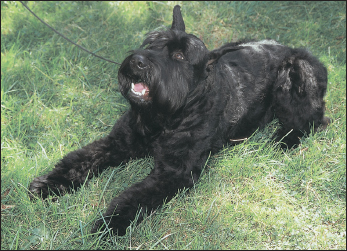
This Giant looks completely at ease while practicing the down/stay.
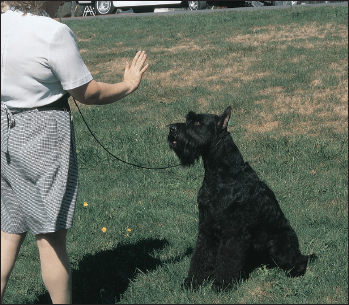
Hand signals can be used in conjunction with verbal commands to teach the various exercises.
The down/stay is taught in the same way once the dog is completely reliable and steady with the down command. Again, don’t rush it. With the dog in the down position on your left side, step out on your right foot as you say “Stay.” Return by walking around in back of the dog and into your original position. While you are training, it’s okay to murmur something like “Hold on” to encourage him to stay put. When the dog will stay without moving when you are at a distance of 3 or 4 feet, begin to increase the length of time before you return. Be sure he holds the down on your return until you say “Okay.” At that point, he gets his treat—just so he’ll remember for next time that it’s not over until it’s over.
THE COME EXERCISE
No command is more important to the safety of your Giant Schnauzer than “Come.” It is what you should say every single time you see the puppy running toward you: “Hans, come! Good dog.” During playtime, run a few feet away from the puppy and turn and tell him to “Come” as he is already running to you. You can go so far as to teach your puppy two things at once if you squat down and hold out your arms. As the pup gets close to you and you’re saying “Good dog,” bring your right arm in about waist high. Now he’s also learning the hand signal, an excellent device should you be on the phone when you need to get him to come to you! You’ll also both be one step ahead when you enter obedience classes.
OKAY!
This is the signal that tells your dog that he can quit whatever he was doing. Use “Okay” to end a session on a correct response to a command. (Never end on an incorrect response.) Lots of praise follows. People use “Okay” a lot and it has other uses for dogs, too. Your dog is barking. You say, “Okay! Come!” “Okay” signals him to stop the barking activity and “Come” allows him to come to you for a “Good dog.”
When the puppy responds to your well-timed “Come,” try it with the puppy on the training leash. This time, catch him off-guard, while he’s sniffing a leaf or watching a bird: “Hans, come!” You may have to pause for a split second after his name to be sure you have his attention. If the puppy shows any sign of confusion, give the leash a mild jerk and take a couple of steps backward. Do not repeat the command. In this case, you should say “Good come” as he reaches you.
COME AND GET IT!
The come command is your dog’s safety signal. Until he is 99% perfect in responding, don’t use the come command if you cannot enforce it. Practice on leash with treats or squeakers, or whenever the dog is running to you. Never call him to come to you if he is to be corrected for a misdemeanor. Reward the dog with a treat and happy praise whenever he comes to you.
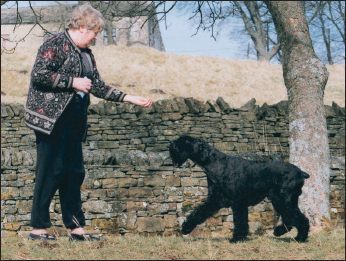
If coming to you always results in something pleasant, your dog should not hesitate to obey your call.
That’s the number-one rule of training. Each command word is given just once. Anything more is nagging. You’ll also notice that all commands are one word only. Even when they are actually two words, you say them as one.
Never call the dog to come to you—with or without his name—if you are angry or intend to correct him for some misbehavior. When correcting the pup, you go to him. Your dog must always connect “Come” with something pleasant and with your approval; then you can rely on his response.
Puppies, like children, have notoriously short attention spans, so don’t overdo it with any of the training. Keep each lesson short. Break it up with a quick run around the yard or a ball toss, repeat the lesson and quit as soon as the pup gets it right. That way, you will always end with a “Good dog.”
Life isn’t perfect and neither are puppies. A time will come, often around ten months of age, when he’ll become “selectively deaf” or choose to “forget” his name. He may respond by wagging his tail (and even seeming to smile at you) with a look that says “Make me!” Laugh, throw his favorite toy and skip the lesson you had planned. Pups will be pups!
THE HEEL EXERCISE
The second most important command to teach, after the come, is the heel. When you are walking your growing puppy, you need to be in control. Besides, it looks terrible to be pulled and yanked down the street, and it’s not much fun either. Imagine how difficult it would be to walk on untrained adult Giant! Your eight-to ten-week-old puppy will probably follow you everywhere, but that’s his natural instinct, not your control over the situation. However, any time he does follow you, you can say “Heel” and be ahead of the game, as he will learn to associate this command with the action of following you before you even begin teaching him to heel.
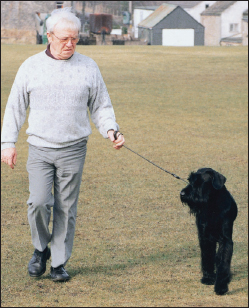
Your Giant Schnauzer must behave well on lead. Walking an untrained Giant would be more than unpleasant—it would be nearly impossible!
BOOT CAMP
Even if one member of the family assumes the role of “drill sergeant,” every other member of the family has to know what’s involved in the dog’s education. Success depends on consistency and knowing what words to use, how to use them, how to say them, when to say them and, most important to the dog, how to praise. The dog will be happy to respond to all members of the family, but don’t make the little guy think he’s in boot camp!
There is a very precise, almost military, procedure for teaching your dog to heel. As with all other obedience training, begin with the dog on your left side. He will be in a very nice sit and you will have the training leash across your chest. Hold the loop and folded leash in your right hand. Pick up the slack leash above the dog in your left hand and hold it loosely at your side. Step out on your left foot as you say “Heel.” If the puppy does not move, give a gentle tug or pat your left leg to get him started. If he surges ahead of you, stop and pull him back gently until he is at your side. Tell him to sit and begin again.
Walk a few steps and stop while the puppy is correctly beside you. Tell him to sit and give mild verbal praise. (More enthusiastic praise will encourage him to think the lesson is over.) Repeat the lesson, increasing the number of steps you take only as long as the dog is heeling nicely beside you. When you end the lesson, have him hold the sit, then give him the “Okay” to let him know that this is the end of the lesson. Praise him so that he knows he did a good job.
The cure for excessive pulling (a common problem) is to stop when the dog is no more than 2 or 3 feet ahead of you. Guide him back into position and begin again. With a really determined puller, try switching to a head collar. This will automatically turn the pup’s head toward you so you can bring him back easily to the heel position. Give quiet, reassuring praise every time the leash goes slack and he’s staying with you.
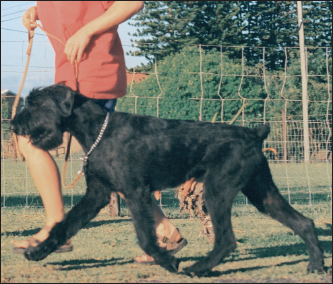
LET’S GO!
Many people use “Let’s go” instead of “Heel” when teaching their dogs to behave on lead. It sounds more like fun! When beginning to teach the heel, whatever command you use, always step off on your left foot. That’s the one next to the dog, who is on your left side, in case you’ve forgotten. Keep a loose leash. When the dog pulls ahead, stop, bring him back and begin again. Use treats to guide him around turns.
Staying and heeling can take a lot out of a dog, so provide playtime and free-running exercise to shake off the stress when the lessons are over. You don’t want him to associate training with all work and no fun—he’s a dog, you know.
HOW DO I GET TO CARNEGIE HALL?
Or the National Obedience Championships? The same way you get your dog to do anything else—practice, practice, practice. It’s how you practice that counts. Keep sessions short, varied, interesting and interspersed with active fun. A bored dog isn’t learning. If you’re feeling out of sorts yourself, quit for the day. Set yourself a reasonable schedule for several brief practice sessions every day and stick to it. Practice randomly throughout the day as you’re doing different things around the house. Lots of praise for that good “Sit” in front of the TV or while waiting for his dinner!
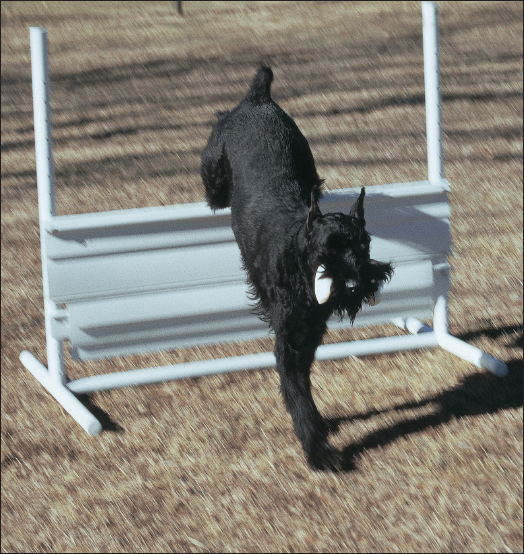
Giant Schnauzers are intelligent, agile and easily trained. From the basics, you can progress to advanced exercises like retrieving over a jump.
TAPERING OFF TIDBITS
Your dog has been watching you—and the hand that treats—throughout all of his lessons, and now it’s time to break the treat habit. Begin by giving him treats at the end of each lesson only. Then start to give a treat after the end of only some of the lessons. At the end of every lesson, as well as during the lessons, be consistent with the praise. Your pup now doesn’t know whether he’ll get a treat or not, but he should keep performing well just in case! Finally, you will stop giving treat rewards entirely. Save them for something brand-new that you want to teach him. Keep up the praise and you’ll always have a “good dog.”
OBEDIENCE CLASSES
The advantages of an obedience class are that your dog will have to learn amid the distractions of other people and dogs and that your mistakes will be quickly corrected by the trainer. Teaching your dog along with a qualified instructor and other handlers who may have more dog experience than you is another plus of the class environment. The instructor and other handlers can help you to find the most efficient way of teaching your dog a command or exercise. It’s often easier to learn from other people’s mistakes than your own. You will also learn all of the requirements for competitive obedience trials, in which you can earn titles and go on to advanced jumping and retrieving exercises, which are fun for many dogs. Obedience classes build the foundation needed for many other canine activities (in which we humans are allowed to participate, too!).
RIGHT CLICK ON YOUR DOG
With three clicks, the dolphin jumps through the hoop. Wouldn’t it be nice to have a dog who could obey wordless commands that easily? Clicker training actually was developed by dolphin trainers and today is used on dogs with great success. You can buy a clicker at a pet shop or pet-supply outlet, and then you’ll be off and clicking.
You can click your dog into learning new commands, shaping or conditioning his behavior and solving bad habits. The clicker, used in conjunction with a treat, is an extension of positive reinforcement. The dog begins to recognize your happy clicking, and you will never have to use physical force again. The dog is conditioned to follow your hand with the clicker, just as he would follow your hand with a treat. To discourage the dog from inappropriate behavior (like jumping up or barking), you can use the clicker to set a timeframe and then click and reward the dog once he’s waited the allotted time without jumping up or barking.
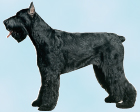
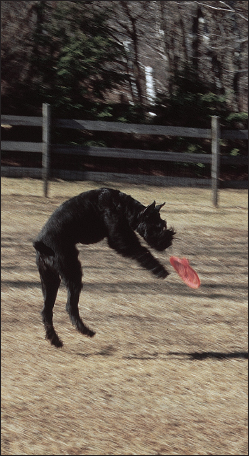
Giant Schnauzers are happy dogs that find fun in all kinds of play and activity.
TRAINING FOR OTHER ACTIVITIES
Once your dog has basic obedience under his collar and is 12 months of age, you can enter the world of agility training. Dogs think agility is pure fun, like being turned loose in an amusement park full of obstacles! In addition to agility, there are specialized areas of canine competition geared toward certain breeds or groups of breeds. Tracking is a scenting instinct test that is open to all “nosey” dogs (which would include all dogs!). For those who like to volunteer, there is the wonderful feeling of owning a therapy dog and visiting hospices, nursing homes and veterans’ homes to bring smiles, comfort and companionship to those who live there.
As a Giant Schnauzer owner, you have the opportunity to participate in Schutzhund competition if you choose. Schutzhund originated as a test to determine the best quality German Shepherd Dogs to be used for breeding stock, but now it is open to other breeds as well. Breeders continue to use it as a way to evaluate working ability and temperament. There are three levels in Schutzhund trials: SchH. I, SchH. II and SchH. III, with each level being progressively more difficult to complete successfully. Each level consists of training, obedience and protection phases. Training for Schutzhund is intense and must be practiced consistently to keep the dog keen. Schutzhund training should be done under the guidance of an experienced trainer. The experience of Schutzhund training is very rewarding for dog and owner.
TIME TO PLAY!
Playtime can happen both indoors and out. A young puppy is growing so rapidly that he needs sleep more than he needs a lot of physical exercise. Puppies get sufficient exercise on their own just through normal puppy activity. Monitor play with young children so you can remove the puppy when he’s had enough, or calm the kids if they get too rowdy. Almost all puppies love to chase after a toy you’ve thrown, and you can turn your games into educational activities. Every time your puppy brings the toy back to you, say “Give it” (or “Drop it”) followed by “Good dog” and throwing it again. If he’s reluctant to give it to you, offer a small treat so that he drops the toy as he takes the treat. He will soon get the idea.
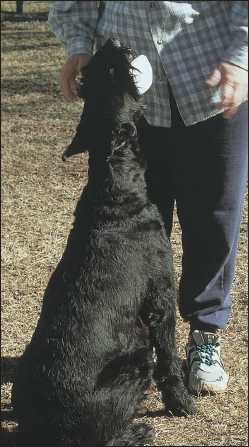
Practicing the retrieve exercise, performed in obedience trials.
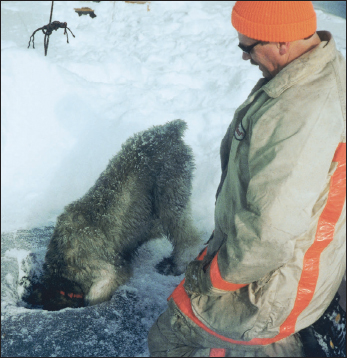
This nosey Giant Schnauzer insists on poking his head into an ice-fishing hole on a frozen lake.
Around the house, your Giant Schnauzer can be taught to do some simple chores. You might teach him to carry a basket of household items or to fetch the morning newspaper. The kids can teach the dog all kinds of tricks, from playing hide-and-seek to balancing a biscuit on his nose. A family dog is what rounds out the family. Everything he does, including sitting at your feet or gazing lovingly at you, represents the bonus of owning a dog.
